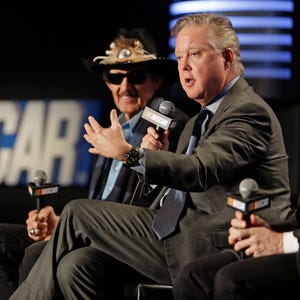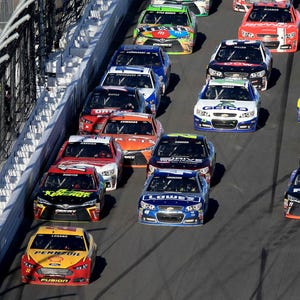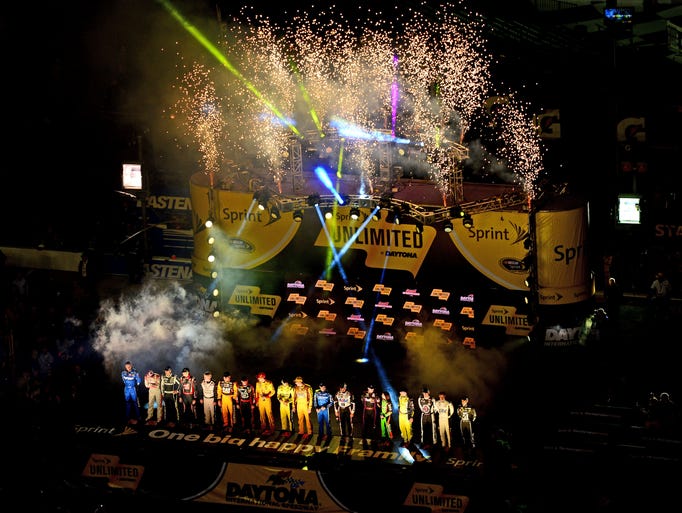NASCAR adopts charter system for team owners – USA TODAY
NASCAR’s business model evolved Tuesday, and teams that provide the cars and drivers that draw the fans might have gained some of the financial security they’ve long sought.
In a stated effort to provide Sprint Cup teams with “increased business certainty and the ability to work more closely with NASCAR to produce best-in-class racing,” series chairman Brian France announced a franchise-like plan designed to “promote a more predictable, sustainable and valuable team business model.”
The show of solidarity between the team owners of NASCAR’s top series and the sanctioning body’s executive was firm at a news conference at the Charlotte (N.C.) Convention Center. All involved conceded and all involved gained, the stakeholders concurred, as NASCAR and its team owners forged an admittedly imperfect but imperative agreement they contend will drastically change the sport and how it does business.
Now comes the implementation of it all.
“I think everyone gave their pint of blood, so to speak,” said Rob Kauffman, who is president of the Race Team Alliance owners organization. “A fair deal is where everyone compromised, no one is a hundred-percent happy, but everyone says, ‘This is a fair balance, I think we can live with it, go forward with it.’
“From my standpoint we got something everyone can live with it, it’s not perfect, but it’s certainly a great step in the right direction and I think everyone’s happy to move forward now.”
In short: chartering has arrived and NASCAR’s paradigm has adjusted from the independent contractor model that marked its first half century. How this will affect both large and small owners will be assessed immediately, as the nine-year deal begins in time for the 2016 season, which commences with the Feb. 21 Daytona 500.
Under the plan, 36 charters will be granted to teams that fielded cars regularly since 2013 and the Sprint Cup race field reduced from 43 to 40 cars. So-called “open” team owners will compete for the final four spots each week.
The 36 charter teams are:
FOUR
Hendrick Motorsports
THREE
Joe Gibbs Racing
Richard Childress Racing
Roush Fenway Racing
Stewart-Haas Racing
TWO
Richard Petty Motorsports
Team Penske
Chip Ganassi Racing
Michael Waltrip Racing
Front Row Motorsports
BK Racing
ONE
Furniture Row Racing
JTG Daugherty Racing
Tommy Baldwin Racing
Germain Racing
Go Fas Racing
Premium Motorsports
Circle Sport Racing
HScott Motorsports
The notable exception is the Wood Brothers, a foundation NASCAR team which has made 1,438 Cup starts and won 98 races but finds itself as an “open” qualifier in its first planned full season since 2006.
Richard Petty, whose flagship team has struggled with financial woes in the last decade, and is now co-owned by a private equity firm including Andrew W. Murstein, called the agreement “the second most important thing that’s ever happened in NASCAR, because now the drivers and owners and stuff now can really work across the aisle.”
“The owners, we don’t understand how NASCAR works, okay? They don’t know how the race teams work,” he continued. “So now we’re going to be in the same room talking about the same problems and solving the problems together.”
The charters are transferrable, ostensibly providing owners tangible assets to sell. Before this system was implemented, team owners had little of tangible value to sell if sponsors pulled out and business failed: buildings and equipment and cars — the latter two becoming more outdated by the week.
The value of a charter figures to be tested immediately, as Michael Waltrip Racing earned two berths as a two-car regular participant before going out of business after last season. Former MWR majority owner Rob Kauffman – president of the Race Team Alliance made up of 18 Cup teams that brokered this deal with NASCAR – possesses the charters. Kauffman is now a partner at Chip Ganassi Racing, which is set with a two-car team. However, the four-car operations of Joe Gibbs Racing and Stewart-Haas Racing were only awarded three charters apiece because they each added new teams — the No. 19 Toyota for Carl Edwards and the No. 41 Chevrolet for Kurt Busch, respectively — since 2013. Kauffman suggested Tuesday that those charters would soon be acquired by JGR and SHR.
According to a NASCAR release, the “system addresses three key areas — participation, governance and economics” and grants owners “new revenue opportunities” including through a greater interest in digital operations. A Team Owner Council also will be established.
Teams must remain in “good standing” by participating each week and can own no more than four charters. NASCAR must approve all sales. A team may lease a charter once during a five-year period.
Owner Tommy Baldwin said he began making capital investments in his one-car outfit when it became apparent that there was wide support for some sort of chartering system. He signed Xfinity Series driver Regan Smith for the No. 7 Chevrolet in January.
“It’s just easy to invest in your company knowing the structure is there now,” Baldwin told USA TODAY Sports. “It was hard not knowing where you were year to year, so we obviously have been working on this for a long time and we knew this was hopefully going to happen before Daytona. This is our first winter that we worked to try and build a better race team rather than just try and stay alive. That comfort was there. Hopefully we can see that hard work take shape on the race track and run better.”
NASCAR’s ownership model since its inception in 1948 has been based around an independent contractor relationship, in which teams bear the financial burden of acquiring human and material assets without a stake in the series itself. Various concessions have been granted to consistent participants seeking continuity and security from sponsors, such as a rule used between 2005 to 2012 that buffered teams in the top 35 in owner points from a fluke weekend of poor qualifying by assuring admission to races. Subsequently, the top 36 cars by speed qualified for races, with the ensuing seven spots filled based on owner points, if needed, and a past champion.
Still, though participation was virtually assured through this system and a series of other fail-safes such as champion’s provisions, owners lacked value for their material because equipment is quickly obsoleted in motorsports and the lack of a franchise model that assured yearly participation.
A kernel of a plan that had been discussed for years, regarding a sport that had operated in a drastically different model for more than a half century ultimately was nearly undone by a deadline. France said there was pressure to conclude a deal before the season began and teams’ focus was consumed by competition matters.
“We were running out of time,” he said. “When the season starts, that would have been it. You never know. This is a very, very complicated thing. If we would have had to table it, pick it back up in the fall, I don’t know about the momentum. Who knows? But it doesn’t matter.”
Follow James on Twitter @brantjames
PHOTOS: 2016 Sprint Cup venues and schedule







